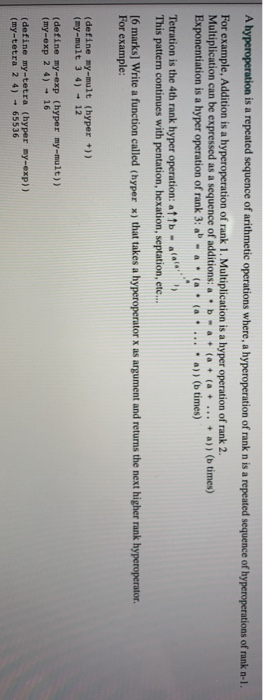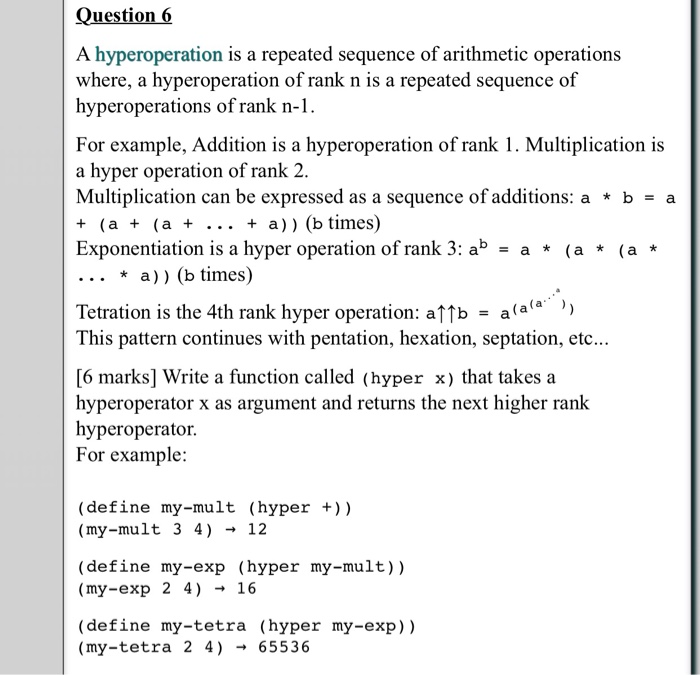language in Scheme

A hyperoperation is a repeated sequence of arithmetic operations where, a hyperoperation of rank n is a repeated sequence of hyperoperations of rank n-1. For example, Addition is a hyperoperation of rank 1. Multiplication is a hyper operation of rank 2. Multiplication can be expressed as a sequence of additions: a. b a + (a + (a + a)) (b times) Exponentiation is a hyper operation of rank 3: a - a. (a. (a..... a)) (b times) Tetration is the 4th rank hyper operation: at fb-ala This pattern continues with pentation, hexation, septation, etc... [6 marks] Write a function called (hyper x) that takes a hyperoperator x as argument and returns the next higher rank hyperoperator. For example: (define my-mult (hyper +)) (my-mult 3 4) - 12 (define my-exp (hyper my-mult)) (my-exp 24) - 16 (define my-tetra (hyper my-exp)) (my-tetra 2 4) - 65536 Question 6 A hyperoperation is a repeated sequence of arithmetic operations where, a hyperoperation of rank n is a repeated sequence of hyperoperations of rank n-1. For example, Addition is a hyperoperation of rank 1. Multiplication is a hyper operation of rank 2. Multiplication can be expressed as a sequence of additions: a + b = a + (a + (a + ... + a)) (b times) Exponentiation is a hyper operation of rank 3: ab = a + (a * (a * ... * a)) (b times) Tetration is the 4th rank hyper operation: a11b = a(ala ) This pattern continues with pentation, hexation, septation, etc... [6 marks) Write a function called (hyper x) that takes a hyperoperator x as argument and returns the next higher rank hyperoperator. For example: (define my-mult (hyper +)) (my-mult 3 4) 12 (define my-exp (hyper my-mult)) (my-exp 2 4) 16 (define my-tetra (hyper my-exp)) (my-tetra 24) 65536 A hyperoperation is a repeated sequence of arithmetic operations where, a hyperoperation of rank n is a repeated sequence of hyperoperations of rank n-1. For example, Addition is a hyperoperation of rank 1. Multiplication is a hyper operation of rank 2. Multiplication can be expressed as a sequence of additions: a. b a + (a + (a + a)) (b times) Exponentiation is a hyper operation of rank 3: a - a. (a. (a..... a)) (b times) Tetration is the 4th rank hyper operation: at fb-ala This pattern continues with pentation, hexation, septation, etc... [6 marks] Write a function called (hyper x) that takes a hyperoperator x as argument and returns the next higher rank hyperoperator. For example: (define my-mult (hyper +)) (my-mult 3 4) - 12 (define my-exp (hyper my-mult)) (my-exp 24) - 16 (define my-tetra (hyper my-exp)) (my-tetra 2 4) - 65536 Question 6 A hyperoperation is a repeated sequence of arithmetic operations where, a hyperoperation of rank n is a repeated sequence of hyperoperations of rank n-1. For example, Addition is a hyperoperation of rank 1. Multiplication is a hyper operation of rank 2. Multiplication can be expressed as a sequence of additions: a + b = a + (a + (a + ... + a)) (b times) Exponentiation is a hyper operation of rank 3: ab = a + (a * (a * ... * a)) (b times) Tetration is the 4th rank hyper operation: a11b = a(ala ) This pattern continues with pentation, hexation, septation, etc... [6 marks) Write a function called (hyper x) that takes a hyperoperator x as argument and returns the next higher rank hyperoperator. For example: (define my-mult (hyper +)) (my-mult 3 4) 12 (define my-exp (hyper my-mult)) (my-exp 2 4) 16 (define my-tetra (hyper my-exp)) (my-tetra 24) 65536









